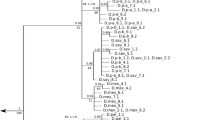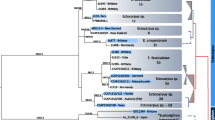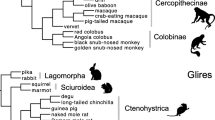Abstract
Most examples of positive selection inferred from nucleotide sequence data involve host-pathogen interactions. However, positive selection also promotes the divergence of proteins mediating spermegg recognition in marine invertebrates. The abalone spermatozoon has a large acrosomal vesicle containing two proteins of 16 kDa and 18 kDa. Lysin, the 16-kDa protein, exhibits species-specificity in dissolving a hole in the egg vitelline envelope through which the sperm swims to reach the egg plasma membrane. The 18-kDa protein coats the sperm acrosomal process and probably mediates fusion of the two gametes. In this review, we compare sequences of both proteins from five species of California abalones. Both proteins show extensive divergence which has been promoted by positive Darwinian selection. The ratios of nonsynonymous to synonymous nucleotide substitutions may be the highest yet discovered for full-length sequences. Although extensive divergence has occurred, there is conservation of the shape and polarity of residues in both proteins. The two acrosomal proteins arose by a gene duplication followed by their extensive divergence. Five hypotheses are presented which attempt to explain the nature of the unknown selective force responsible for the robust positive selection. The positive selection may, in some unknown way, be related to the establishment of prezygotic barriers to reproduction. Because positive selection promotes the divergence of unrelated, species-specific gamete recognition proteins in both abalones and sea urchins, we predict that positive selection may be a general phenomenon in the evolution of gamete recognition systems in marine invertebrates.
Similar content being viewed by others
References
Andersson MB (1994) Sexual selection. Princeton University Press, Princeton, NJ
Altschul SF, Gish W, Miller W, Myers EW, Lipman DJ (1990) Basic local alignment search tool. J Mol Biol 21:403–410
Bayne CJ (1990) Phagocytosis and non-self recognition in invertebrates. Bioscience 40:723–731
Biosym Profiles 3D users guide (1993) Version 2.3.0, Biosym Technologies, San Diego
Bowie JU, Luthy R, Eisenberg D (1991) A method to identify protein sequences that fold into a known three-dimensional structure. Science 253:164–170
Darwin C (1871) The descent of man and selection in relationship to sex. John Murray, London
Dobzhansky Th (1940) Speciation as a stage in evolutionary divergence. Am Nat 74:312–321
Endo T, Ikeo K, Gojobori T (1996) Large-scale search for genes on which positive selection may operate. Mol Biol Evol 13:685–690
Foltz KR (1995) Sperm-binding proteins. Int Rev Cytol 163:249–303
Genetics Computer Group (1991) Program manual for the GCG package, Version 7, University of Wisconsin, Madison
Gribskov M, Luthy R, Eisenberg D (1990) Profile analysis. Methods Enzymol 183:146–159
Haino-Fukushima K, Usui N (1986) Purification and immunocytochemical localization of the vitelline coat lysin of abalone spermatozoa. Dev Biol 115:27–34
Haino-Fukushima K, Kasai H, Isobe T, Kimura M, Okuyama T (1986) The complete amino acid sequence of vitelline coat lysin. Eur J Biochem 154:503–510
Howard DJ (1993) Reinforcement: origins, dynamics and fate of an evolutionary hypothesis. In: Harrison RG (ed) Hybrid zones and the evolutionary hypothesis. Oxford University Press, Oxford, pp 46–69
Hughes AL (1994) The evolution of functionally novel proteins after gene duplication. Proc R Soc Lond [Biol] 256:119–124
Hughes AL, Nei M (1988) Pattern of nucleotide substitution at major histocompatibility complex loci reveals overdominant selection. Nature 35:167–170
Hughes AL, Ota T, Nei M (1990) Positive-Darwinian selection promotes charge profile diversity in the antigen binding cleft of Class I major histocompatibility complex molecules. Mol Biol Evol 7: 515–524
Jukes TH, Cantor CR (1969) Evolution of protein molecules. In: Munro HN (ed) Mammalian protein metabolism. Academic Press, New York, p 21
Kumar S, Tamura K, Nei M (1993) MEGA: molecular evolutionary genetics analysis, version 1.01. The Pennsylvania State University, University Park, PA 16802
Lee Y-H (1994) Abalone sperm lysin: molecular evolution of a fertilization protein, implications concerning the species-specificity of fertilization and speciation in marine invertebrates. PhD Thesis, University of California, San Diego
Lee Y-H, Vacquier VD (1992) The divergence of species-specific abalone sperm lysins is promoted by positive Darwinian selection. Biol Bull 182:97–104
Lee Y-H, Vacquier VD (1995) Evolution and systematics in Haliotidae (mollusca: gastropoda): inference from DNA sequences of sperm lysin. Marine Biol 124:267–278
Lee Y-H, Ota T, Vacquier VD (1995) Positive selection is a general phenomenon in the evolution of abalone sperm lysin. Mol Biol Evol 12:231–238
Lindberg DR (1991) Evolution, distribution and systematics of Haliotidae. In: Shepherd SA, Tegner MJ, Guzmán del Próo SA (eds) Abalone of the world: biology, fisheries and culture. Blackwells, London, p3
Liou LW, Price TD (1994) Speciation by reinforcement of premating isolation. Evolution 48:1451–1459
Metz EC, Palumbi SR (1996) Positive selection and sequence rearrangements generate extensive polymorphism in the gamete recognition protein bindin. Mol Biol Evol 13:397–406
Metz EC, Kane RE, Yanagimachi H, Palumbi SR (1994) Fertilization between closely related sea urchins is blocked by incompatibilities during sperm-egg attachment and early stages of fusion. Biol Bull 187:23–34
Miraglia SJ, Glabe CG (1993) Characterization of the membrane-associating domain of the sperm adhesive protein, bindin. Biochim Biophys Acta 1145:191–198
Miyata T, Miyazawa S, Yasunaga T (1979) Two types of amino acid substitutions in protein evolution. J Mol Evol 12:219–236
Nei M, Gojobori T (1986) Simple methods for estimating the numbers of synonymous and nonsynonymous nucleotide substitutions. Mol Biol Evol 3:418–426
Nei M, Chakraborty R, Fuerst PA (1976) Infinite allele model with varying mutational rate. Proc Natl Acad Sci USA 73:4164–4168
Noor MA (1995) Speciation driven by natural selection in Drosophila. Nature 375:674–675
Palumbi SR (1994) Genetic divergence, reproductive isolation and marine speciation. Annu Rev Ecol Syst 25:547–572
Palumbi SR, Metz EC (1991) Strong reproductive isolation between closely related tropical sea urchins (genus Echinometra). Mol Biol Evol 8:227–239
Pearson WR, Lipman DJ (1988) Improved tools for biological sequence comparison. Proc Natl Acad Sci USA 85:2444–2448
Rice WR (1996) Sexual antagonistic male adaptation triggered by experimental arrest of female evolution. Nature 381:232–234
Rice WR, Hostert EE (1993) Laboratory experiments on speciation: what have we learned in 40 years? Evolution 47:1637–1653
Rost B, Sander C (1994) Combining evolutionary information and neural networks to predict protein secondary structure. Proteins 19:55–72
Shaw A, McRee DE, Vacquier VD, Stout CD (1993) The crystal structure of abalone sperm lysin. Science 262:1864–1867
Shaw A, Fortes PGA, Stout CD, Vacquier VD (1995) Crystal structure and subunit dynamics of the abalone sperm lysin dimer: egg envelopes dissociate dimers, the monomer is the active species. J Cell Biol 130:1117–1125
Smith DW (1988) A complete, yet flexible, system for DNA/protein sequence analysis using VAX/VMS computers. Comput Appl Biosci 4:212
Swanson WJ, Vacquier VD (1995a) Liposome fusion induced by a Mr 18,000 protein localized to the acrosomal region of acrosome-reactive abalone spermatozoa. Biochemistry 34:14202–14208
Swanson WJ, Vacquier VD (1995b) Extraordinary divergence and positive Darwinian selection in a fusagenic protein coating the acrosomal process of abalone spermatozoa. Proc Natl Acad Sci USA 92:4957–4961
Uzzell T, Corbin KW (1971) Fitting discrete probability distributions to evolutionary events. Science 172:1089–1096
Vacquier VD, Lee Y-H(1993) Abalone sperm lysin: unusual mode of evolution of a gamete recognition protein. Zygote 1:181–196
Vacquier VD, Carner KR, Stout CD (1990) Species-specific sequences of abalone sperm lysin, the sperm protein that creates a hole in the egg envelope. Proc Natl Acad Sci USA 87:5792–5796
Vacquier VD, Swanson WJ, Hellberg ME (1995) What have we learned about sea urchin sperm bindin? Dev Growth Differ 37:1–10
Author information
Authors and Affiliations
Corresponding author
Rights and permissions
About this article
Cite this article
Vacquier, V.D., Swanson, W.J. & Lee, YH. Positive darwinian selection on two homologous fertilization proteins: what is the selective pressure driving their divergence?. J Mol Evol 44 (Suppl 1), S15–S22 (1997). https://doi.org/10.1007/PL00000049
Received:
Accepted:
Issue Date:
DOI: https://doi.org/10.1007/PL00000049




